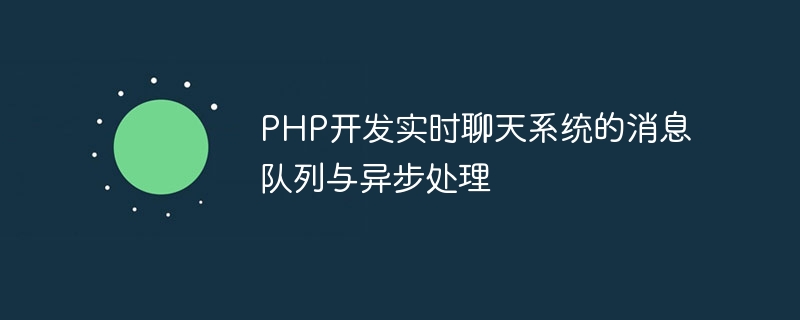

Message queue and asynchronous processing of real-time chat system developed in PHP
In modern Internet applications, real-time chat system has become a necessary function. In order to ensure the smooth operation and user experience of the chat system, message queue and asynchronous processing technology have become the preferred solutions for developers. In this article, I will introduce how to develop a real-time chat system using PHP and use message queues and asynchronous processing to improve performance.
In order to implement the real-time chat system, we will use the Laravel framework. First, we need to create a Laravel project and install related dependency packages. The project can be created through the following command:
composer create-project --prefer-dist laravel/laravel chat
Next, we need to install Redis as the backend storage of the message queue. You can install Redis through the following steps:
Download and unzip Redis:
wget http://download.redis.io/releases/redis-6.0.10.tar.gz tar xzf redis-6.0.10.tar.gz cd redis-6.0.10
Compile and install Redis:
make sudo make install
Run Redis:
redis-server
After installing Redis, we can start writing code. First, we need to create a controller named ChatController and add the following code:
<?php
namespace AppHttpControllers;
use IlluminateHttpRequest;
use IlluminateSupportFacadesRedis;
class ChatController extends Controller
{
public function pushMessage(Request $request)
{
$message = $request->input('message');
Redis::publish('chat', json_encode([
'message' => $message,
'user' => $request->user()->name,
'timestamp' => microtime(true)
]));
return response()->json(['success' => true]);
}
}In the above code, we define a pushMessage method, which receives a message and pushes it to the Redis message queue middle.
Next, we need to create a queue listener named MessageListener. The listener can be created through the following command:
php artisan make:listener MessageListener --queued
After creation, we need to modify the following code to associate the listener with the Redis message queue:
<?php
namespace AppListeners;
use IlluminateContractsQueueShouldQueue;
use IlluminateQueueInteractsWithQueue;
use IlluminateSupportFacadesLog;
class MessageListener implements ShouldQueue
{
use InteractsWithQueue;
public function handle($message)
{
Log::info('New message: ' . $message);
// 处理收到的消息,例如保存到数据库或推送给相应的用户
}
}In the above code, we define A handle method to handle the received message. In this method, you can perform corresponding business logic processing as needed.
Finally, we need to register the listener. In app/Providers/EventServiceProvider.php, we need to add the following code:
protected $listen = [
'AppEventsMessageReceived' => [
'AppListenersMessageListener',
],
];Next, we need to create an event subscriber named EventSubscriber. Subscribers can be created through the following command:
php artisan make:subscriber EventSubscriber
After creation, we need to add the following code to define the push message event:
<?php
namespace AppSubscribers;
use AppEventsMessageReceived;
use IlluminateSupportFacadesEvent;
class EventSubscriber
{
public function handle(MessageReceived $event)
{
Event::fire('AppEventsMessageReceived', [$event->message]);
}
public function subscribe($events)
{
$events->listen(
'AppEventsMessageReceived',
'AppListenersMessageListener@handle'
);
}
}In the above code, we define the handle method and subscribe method to handle push message events.
Finally, we need to register the event subscriber to Laravel. In app/Providers/EventServiceProvider.php, we need to modify the following code:
protected $subscribe = [
'AppSubscribersEventSubscriber',
];After completing the above steps, we can push messages to the server through Ajax in the front-end code. The following is a simple example:
$.ajax({
url: '/push-message',
type: 'POST',
data: { message: 'Hello world' },
success: function(response) {
console.log(response);
}
});By using message queues and asynchronous processing technology, we can greatly improve the performance and user experience of the real-time chat system. Hopefully this article will help you better understand and apply these techniques.
The above is the detailed content of Message queue and asynchronous processing of real-time chat system developed with PHP. For more information, please follow other related articles on the PHP Chinese website!
 Solution to Win7 folder properties not sharing tab page
Solution to Win7 folder properties not sharing tab page
 what is vuex
what is vuex
 How to clean the computer's C drive that is too full
How to clean the computer's C drive that is too full
 Mathematical modeling software
Mathematical modeling software
 The difference between vscode and vs
The difference between vscode and vs
 How to type the inscription on the coin circle?
How to type the inscription on the coin circle?
 How to decrypt bitlocker encryption
How to decrypt bitlocker encryption
 How to solve the slow download problem of Baidu Netdisk
How to solve the slow download problem of Baidu Netdisk